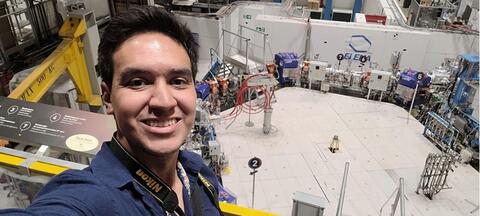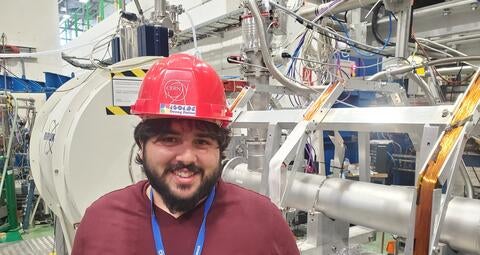Three young physicists at the University of California, Riverside, have been thinking big. Gigantic-particle-accelerator big. Undergraduates Andrew Caruso, Robert Vasquez, and Selim Zoorob did internships this summer at the European Organization for Nuclear Research, or CERN. The center is home to the Large Hadron Collider, or LHC, the world’s largest and most powerful particle accelerator.
The LHC, a circular tunnel with a circumference of 17 miles, smashes particles by firing two beams of them traveling in opposite directions in the tunnel. After several rounds, the particles approach the speed of light and collide head-on, their debris offering physicists an opportunity to study the quantum world.
Caruso, 22, was motivated to apply for the CERN internship because he was interested in both experimental particle physics and a software used at CERN called ROOT. After he was offered the internship, he took a particle physics course at UCR, which further sparked his interest in the field.
Having never been to Europe or pursued such an opportunity, Caruso was unsure of how daily life and work would be at the center.
“I thought the work would be similar to what I did with the ROOT software in my undergraduate physics research at UCR and daily life would be similar to that on campus,” he said. “As I gained more experience, however, I found CERN exceeded these expectations. I ended up not using ROOT software at all but instead created a program using Python, a programming language.”
Caruso found CERN has a rich diversity of international students and offered him a range of opportunities in both computer science and physics through workshops and lectures. He appreciated that CERN promoted communication among the students and hosted extracurricular activities through clubs and events.
“It is easy to find things to do and meet new people,” he said. “Also, all the students are CERN staff and are treated as such. I was expected to work on my project and take advantage of the learning and social opportunities.”
The project Caruso worked on at CERN is called “Model of the NA62 CEDAR.”
“The NA62 experiment is a fixed target experiment wherein a proton beam hits a fixed target and produces particles called kaons whose decays are researched,” he said.
Caruso believes his CERN experience will enhance his interest and skills in the field of particle physics, ultimately benefiting his career. In his free time, he traveled to Geneva and places in or near Switzerland.
“This was a once in a lifetime opportunity to not only engage in intriguing scientific research, but learn new topics as well as meet many people,” he said. “It is amazing to work with and talk to people from a broad spectrum of backgrounds. Certainly, there are language barriers sometimes, but it is fun to learn other people’s languages and culture. It is also incredible how many people are part of CERN, since the sites are essentially small cities with their own fire brigade, hostels, cafeterias, buses, and medical center. There are many people, not only scientists, who keep CERN functional.”

Vasquez, 27, a first-generation student, had always wanted to visit CERN for the work and research done there. But when he saw the internship application through the UCR physics undergraduate digital bulletin board, his first thought was not to apply.
“I thought I didn’t have a chance,” he said. “But my mom would have encouraged me to apply for it and after losing her to COVID-related complications last year I thought it would be a good way to honor her memory.”
CERN exceeded Vasquez’s expectations in terms of the physical size of the facility and the research being done there.
“What had me most excited at CERN is a facility called the ‘Antimatter Factory,’ where they produce and experiment with antimatter, including studies on how it interacts with gravity,” he said.
For Vasquez, the benefit of working with an international team of scientists was getting to learn how other countries differ from the U.S. in their approach to education, their scientific interests, and their culture.
The project he worked on focused on expanding the functionality of the AppLE.py program.
Vasquez explained that particle accelerators use magnets to change the direction and focus of the particles that move through them. To know how these particles will behave when going through these magnets requires a set of equations that dictate behavior. For one magnet and one particle the calculations are relatively simple, but for several thousands of particles going through many magnets the calculations can be lengthy and tedious.
“A program called MAD-X was developed to simulate the beams moving through these magnets,” he said. “This program works but can be difficult to run for repeated simulations. To make things easier a program called AppLE.py is being developed as a user-friendly, graphic interface in Python. My job was to program in additional functionality to the application to make the jobs of those using these magnets easier.”
Vasquez believes his CERN experience stands out in his resume. He has already talked to potential employers interested in looking at his application because of the CERN mention.
In his first trip to Europe and his first trip outside the southwest region of the U.S., Vasquez picked up photography and took numerous pictures at Zurich, Paris, Mont Blanc, and other places.
To the student on the fence about taking up his kind of internship, Vasquez offers words of encouragement.
“My mom would say the worst they can tell you is no,” he said. “It’s better to try and fail rather than always wonder whether or not you could have gotten in. Even if you think you shouldn’t apply because your field isn’t primarily physics, there is a place for you here in terms of computer science, engineering, math, and other disciplines.”

Zoorob, 22, graduated earlier this summer and was glad to have had the opportunity to spend three months at CERN. His journey there began when one day on campus he saw a posting about the internship on the undergraduate physics section on iLearn.
“Going to CERN was always a dream of mine and it felt surreal when I applied for the internship,” he said. “It was a lot of work once I got there, which was the most exciting part of the trip.”
Zoorob found it both humbling and inspiring to be a part of an international team of scientists.
“I got to be part of all the behind-the-scenes meetings and preparation,” he said. “It was fascinating to see how so many ideas and moving parts come together to make a science experiment. It was amazing to witness how science is actually done in the real world.”
Zoorob worked on two projects at CERN: “Radiation detected Zero to UltraLow-Field Nuclear Magnetic Resonance (RD-ZULF-NMR)” and “Liquid β-NMR studies of the interaction of Na and K cations with DNA G-quadruplex structures.”
“I got to participate in discussions surrounding the development of the RD-ZULF-NMR project, work on a section of the experimental setup, and move this section to a hospital in Geneva,” he said. “For the Liquid β-NMR project, I assisted in the collection and processing of data.”
According to Zoorob, the RD-ZULF-NMR project could revolutionize the field of biochemistry by offering a new visualization tool to study molecules. It could also be beneficial to the medical field by making MRI-machines more compact, affordable, and safe.
“I often took the tram to visit Geneva — a pedestrian-friendly city with inviting local markets, many tourist attractions, and museums,” he said. “I have been amazed by Geneva’s rich history and visiting the Musée d'ethnographie de Genève, or museum of ethnicity in Geneva, has been my favorite part of it.”
For Zoorob CERN will have a place close to his heart because it taught him how to work like a scientist and opened his mind to exploration.
“A certain sense of mystique can be found in every little corner at CERN — from the library that exclusively has physics-related books, to the wonderful laboratories I had only previously seen in textbooks,” he said. “What is amazing about CERN is its sense of decentralization. There isn't a ‘main building’ but rather different facilities that come together to form a complex system. I was free and encouraged to explore this system that once seemed impossible to understand.”
The CERN internships for the UCR students began in mid-June and ended in mid-August. Faculty in the UCR Department of Physics and Astronomy who assisted and guided Caruso, Vasquez, and Zoorob are Yongtao Cui, Bill Gary, Owen Long, Flip Tanedo, and Stephen Wimpenny.